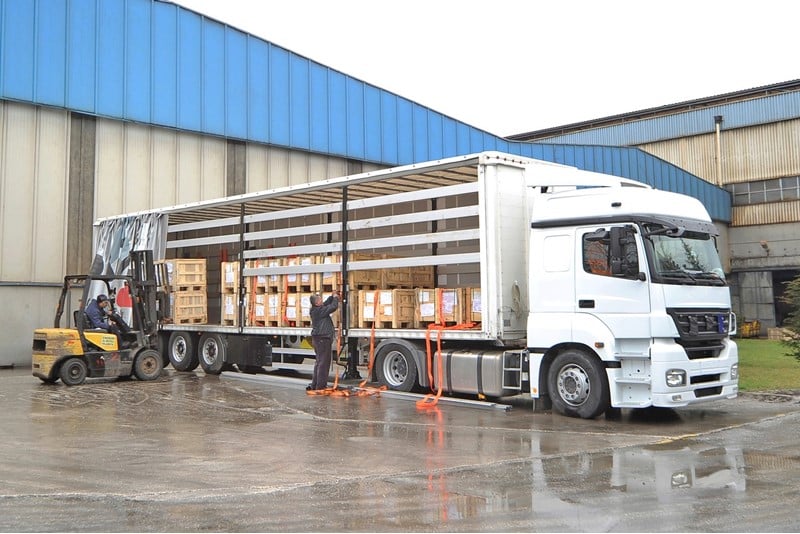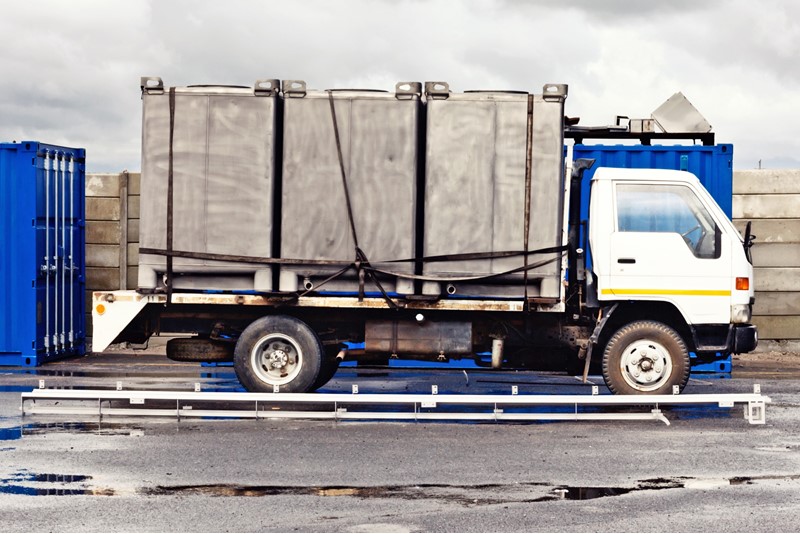Overloaded vehicles pose a significant risk to the safety of drivers and other road users. But they also have cost implications and can potentially damage your business’s reputation.
Since 2015, Driver and Vehicle Standards Agency (DVSA) has tested more than 44,000 vans at the roadside and found almost a quarter to be overloaded, while there were 80 prosecutions for overloaded heavy goods vehicles (HGVs) last year alone.
If one of your company’s vehicles is found to be overloaded, the driver could face a fixed penalty notice from £100 to £300, dependent on the overload.
However, if it exceeds 30%, then the enforcement authorities will report the driver with a view to prosecution. A fine of several hundred pounds is a likely outcome if the individual is found guilty.
The financial implications don’t end there. The owner may also be prosecuted for causing or permitting the offence, with penalties on conviction likely to be several thousand pounds for each axle overload, and for the gross overload as well.
Overloading can result in the issuing of a prohibition notice and the vehicle being immobilised by the DVSA until the excess is removed.
Matters are likely to become more serious, and the penalties heavier, if the overload is enough to justify a charge of using a vehicle in a dangerous condition, or if the vehicle happens to be a truck.
If that is the case, the Traffic Commissioner must be informed of any overloading conviction, resulting in action against the operator’s O-licence if the offence is sufficiently serious, or if the operator has committed a number of other offences at the same time.
It will also affect the firm’s OCRS (Operator Compliance Risk Score) which means its trucks are likely to be stopped by the DVSA more frequently and it will affect its eligibility for Earned Recognition status.
Derek Hack, sales director at axle weighing company Axtec, says: “The fine that is handed out is usually the least of a business’s problems. If you were due to deliver some product to one of your customers and you are found to be overloaded and prohibited from moving, you face a situation where your customer is waiting for the goods. Will that customer use you again? The fine, to some degree, is insignificant.”
Overloaded vehicles pose a safety risk to the driver, other road users and the public, according to Logistics UK.
“The brakes, suspension and tyres of vehicles are designed to meet the needs of what is expected to be carried, which is clearly shown on the manufacturer’s plate,” says Phil Lloyd, Logistics UK head of engineering policy.
“Exceeding these weights can have a detrimental effect on those components which can compromise the safety of the vehicle and, hence, overall road-safety. Additionally, some overloaded vehicles can damage our road infrastructure, causing an unnecessary financial burden on our economy.
“Transporting a load securely not only keeps others on the road safe, but also ensures that vehicles and loads arrive on time, without
incident; paying close attention to load security should be a primary concern for all road haulage operators.”
It is estimated that overloaded vehicles cost more than £50 million per year through additional wear and tear on the UK road network. Heavy axles cause proportionately far more damage, and overloaded drive axles (legal limit 11.5 tonnes) are the biggest single cause of excessive wear and tear on roads.
Fleets will also pay for excess fuel use, increased wear and tear on the vehicle and an increased risk of downtime due to mechanical failure.
DVSA director of enforcement Marian Kitson says: “Lorries have a maximum load weight for a reason. Operators and drivers are putting the public in serious danger by overloading them.
“Overloaded brakes and tyres don’t work properly and the results can be catastrophic. That’s why we won’t hesitate in prosecuting those who put people’s lives at risk and undercut responsible operators.”
Know your weights
It may sound simple, but understanding the capabilities and restrictions of your fleet is the first step to ensure your vehicles are not
overloaded. Consider the following:
Axle weight: this is the total weight transmitted to the road by all the wheels on one axle.
Gross vehicle weight (gvw): this is the weight of a vehicle and its load.
Train weight: this is the weight of a vehicle, a trailer and its load.
Plated weight: This is either the design weight limit given on a manufacturer’s plate or the legal weight limit given on the department’s plate.
A vehicle is overloaded if it exceeds the plated weight limits. A vehicle could be overloaded on all its axles, on its gross weight and/or on its train weight.
Each of these would be separate offences. So, a three-axle articulated truck which exceeded the plated weights on the first axle, second axle and gvw would make both the vehicle operator and driver responsible for three separate offences.
When calculating how much weight your vehicle can carry, remember to include the weight of the driver, passengers and anything else that’s usually on board while the vehicle is travelling along the road.
Weighing your vehicle
There are a number of ways to weigh a vehicle and it’s important to consider which method best suits your business.
Public weighbridges allow drivers to pull up and, for a small fee, weigh their vehicle. The law allows a vehicle to be driven to a weighbridge even if it is overweight.
However, in the view of Logistics UK, there is a shortage of public weighbridges across the UK; furthermore, it adds, there is little information available on where these are located, or their accessibility.
Operators with a larger operation, or a more frequent need to weigh vehicles, should consider installing their own weighbridge on-site.
A static axle weighbridge suitable for weighing light commercial vehicles (LCVs) costs about £8,000.
Fleets operating multi-axle heavy trucks with their more complex suspension systems should consider installing a dynamic axle weighbridge. More expensive than the static type, they typically cost around £20,000.
Hack says: “You have to pick the right machine for the application. Supermarkets send a full load from depot to shop and come back very light. They benefit from having a fixed system in the yard.
“If you were a plant hire company, they are picking plant up as well. The load on the vehicle is changing throughout the day. In that application you need equipment on the vehicle, so the driver knows if he is overloaded or not.”
On-vehicle weighing systems cost from £1,000 per vehicle and allow the driver and/or operator to monitor its weight from an in-cab device or remotely, using a telematics link.
Portable weigh pads are useful for businesses with multiple satellite locations. They cost around £6,000 and allow an operator to weigh an axle by parking on or driving over the device. They’re susceptible to damage and not practical for regular use, however.
“I would say 90% of the enquiries we get are for portable weigh pads. They are the most misunderstood product in the axle-weighing industry,” Hack says.
It’s not common for on-vehicle systems to be installed by manufacturers, but Groupe PSA is installing an overload detector on its new range of LCVs sold under the Peugeot, Citroën and Vauxhall brands.
The Overload Indicator two-stage system warns drivers when they are within 10% of the maximum gvw and provides a second alert if they exceed the vehicle’s limit.
Alerts flash up at the rear of the van and on the instrument cluster display to ensure drivers don’t miss the warning when loading and when they are about to set off.
Hyundai is also working on a similar device that will interact with the powertrain on electric commercial vehicles.
The ability to calculate the gross weight of a vehicle on the move means that an electric vehicle’s torque output can be optimised to maximise estimated remaining range.
Weighing vehicles can make you money
One of the biggest prohibiting factors of vehicle weighing is the expense of buying the equipment or paying to use a public weighbridge. But, fleet operators could, effectively, get a weighbridge for free if they let other businesses use their’s for a nominal fee.
“If you are a pallet network, for example, your yard is quiet during the day. All the action happens at night,” says Hack. “If they had a weighbridge that other hauliers could use during the day, they could generate significant income to cover the cost of the installation. The system could pay for itself within two years, then it’s earning them a profit.”
Operators could typically charge other users between £6 and £15 for the use of a weighbridge installed on their site.
Not all businesses want to weigh their vehicles to see if they are overweight; some want to check they aren’t underweight. If you can accurately measure the weight of your vehicles you can run them at full capacity, which can reduce the number of vehicles you need to send on a particular route.
Transporting over-sized and heavier items
Load should be divided up and transported within the legal weight limits, but there are times when this isn’t possible. Some heavy or out-sized items need to be transported by road, including aircraft wings, mobile homes and construction equipment.
In these cases, the vehicle used to take the load, classed as a Special Types Vehicle (STV), will be used under the authority of the Road Vehicles (Authorisation of Special Types) (General) Order 2003 (STGO).
To comply, they must have a valid STGO order issued by Highways England and the Vehicle Certification Agency (VCA). And fleets can still fall foul of the rules.
Three major haulage firms were recently prosecuted for overloading their vehicles under STGO.
WS Transportation, of Runcorn, whose directors are Edward and William Stobart, was fined £27,000 when it transported a heavy crane using a trailer with insufficient load capability.
Last year, Metcalfe Farms Haulage of Leyburn was fined £10,000 for overloading one of its HIAB crane articulated vehicles, while Court Smiths (Gloucester) of Stonehouse was fined £40,000 for overloading a vehicle and breaking its design weight.
Driver and Vehicle Standards Agency fines for overloading
5%-10% over the limit: £100 fine
10%-15% over the limit: £200 fine
15%-30% over the limit: £300 fine
30%+: Court summons
DVSA examiners will allow a 5% leeway before issuing a fixed penalty notice, provided the relevant weight has not been exceeded by one tonne or more.
Any vehicle weighing 30% more than the limit could trigger a summons.
Above 30%, the DVSA would consider the vehicle to be overloaded to the point that it is a clear hazard to other road users. In such cases the driver can be charged with dangerous driving – which potentially carries a prison sentence.
How to prevent overloading
Seven recommendations to ensure your load is safe and secure from Phil Lloyd, Logistics UK head of engineering policy
1 Risk assessment: Consider the restraint equipment, typical load, and nature of your journey before carrying out a risk assessment as part of your health and safety requirement. Share this information with all those who are involved in the loading process.
2 Vehicle suitability: Make sure the vehicle is suitable for carrying the intended consignment and that it is well maintained.
3 Load and platform: Make sure the packaging and pallets are in good condition; any degradation could result in the goods coming free of their restraints. Also check the load platform and vehicle bodywork to ensure there is no damage or structural weakness.
4 Load planning: Ensure the load is spread evenly over the axles. Arrange the load in accordance with the delivery schedule and keep the load as low as possible to minimise the centre of gravity. Redistribute the load at times of delivery.
5 Restraint equipment: Always use appropriate load-restraint equipment, including lashing or ratchet straps, ropes, chains, bars or webbing.
6 Walkaround checks: Before leaving the depot, after stops and at the end of each delivery, the driver should examine strap or restraint tension and fitment, goods moved during transit and the security of the trailer curtain, doors and tail lift.
7 Raising awareness: Make sure training is provided to drivers and loading assistants. It should focus on driving style, safety equipment, load layout, vehicle configuration and emergency procedures.
Towing a trailer? Things to consider
When a trailer is attached to your vehicle, the combination can come within the scope of additional rules.
Licences
A standard car licence, issued from January 1997, enables the holder to drive a vehicle with gvw up to (and including) 3.5 tonnes and a trailer up to 750kg maximum authorised mass (MAM).
It also allows the towing of a trailer above 750kg MAM, if the gross train weight does not exceed 3.5 tonnes and the weight of the trailer does not exceed the unladen weight of the drawing vehicle.
Licences issued before January 1997 allow a driver to tow a trailer above 750kg gvw, behind a 3.5-tonne vehicle. Drivers who gained their licence after this date will need to take a trailer test in order to tow anything heavier.
Drivers’ hours
GB domestic drivers’ hours rules apply to drivers on journeys within the UK who are exempt or excluded from the EU tachograph rules.
In any working day, a driver is restricted to a maximum of 10 hours daily driving and an 11-hour daily duty limit (excluding rest and breaks).
However, drivers of goods vehicles not more than 3.5 tonnes gvw and dual-purpose vehicles engaged in a service of inspection, cleaning, maintenance, repair, installation and fitting are exempt from the 11-hour daily duty limit.
In addition, drivers who do not drive for more than four hours on every day of a fixed week (commencing midnight Sunday/Monday) are also exempt from the duty limit.
EU rules may apply if the vehicle combination exceeds 3,500kg gross train weight and is travelling within the EU, European Economic area or Switzerland. There are a number of exemptions, including the non-commercial carriage of goods or vehicles being used by tradespeople
Operator licencing
You need a licence to carry goods in a lorry, van or other vehicle if the vehicle and the trailer are plated and the total of their gross plated weights is more than 3,500kg or the total unladen weight of the vehicle and trailer combination is more than 1,525kg.
You’ll need a standard licence if you’re carrying other people’s goods for hire or reward (such as working as a courier or freight transport business) and the vehicle and trailer combination exceeds the weight limits above for a single vehicle.






















Login to comment
Comments
No comments have been made yet.